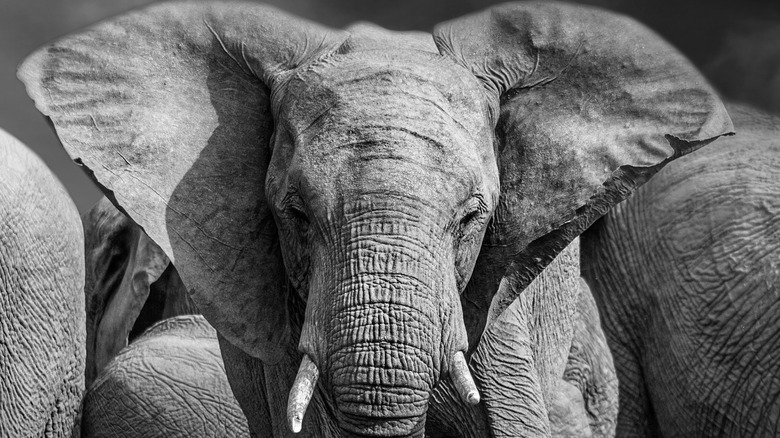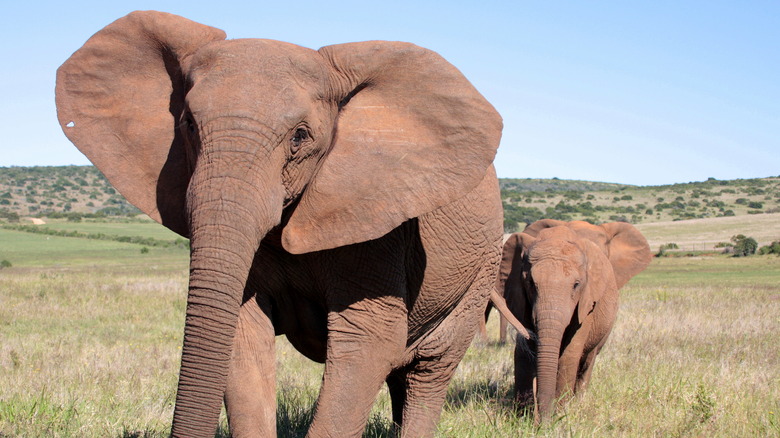Elephant Poaching Has Forced The Species To Evolve Without A Key Body Part
According to the World Wildlife Fund (WWF), it's estimated that 20,000 elephants are poached annually for their tusks. In Mozambique alone, Mongabay reported that half of its elephant population was slaughtered due to poaching between 2010 and 2015. As the International Anti-Poaching Foundation explains, poaching is the act of illegally killing animals such as elephants and rhinos. Elephants, which are found primarily on the continents of Asia and Africa, are specifically targeted for the ivory in their tusks.
Both male and female elephants can grow tusks. Additionally, elephants can be either left or right-tusked, in the same way that humans are either left or right-handed (via WWF). Per the International Fund for Animal Welfare (IFAW), elephants use their tusks, which are like teeth, to dig, fight, and protect themselves. That being said, ivory is a highly valued material. It can be used to make trinkets and has alleged medicinal properties. The Atlantic writes that through the years, archaeologists have uncovered various historical items, such as needles, buttons, combs, and much more, all made of ivory.
Although several countries, including the United States and the United Kingdom, have made ivory trading illegal, this has done little to curtail elephant poaching (per the IFAW). However, in 1992, NPR states, researchers noticed that elephants in Gorongosa National Park in Mozambique were being born without tusks. As it turns out, this was their key to survival.
The Mozambican Civil War
NPR writes that researchers began to study the tuskless elephants at Gorongosa National Park in 1992, the year that the Mozambican Civil War came to an end. According to Tufts University, the war was between the government-controlled Mozambique Liberation Front (known as FRELIMO) and a rebel group known as the Mozambican National Resistance (also referred to as RENAMO). The conflict began soon after Mozambique received its independence from Portugal. One of the reasons behind the developing tensions between the two groups is that RENAMO began to threaten the stability that FRELIMO had created after the country gained its independence (via Britannica).
Ultimately, Black Past reports, 1 million people died during the 15-year war. Per Human Rights Watch, numerous atrocities were committed. The conflict led to famine and the recruitment of child soldiers. Many civilians were killed; many others were severely mutilated. Death could be caused by fighting, starvation, or disease. Moreover, a 2003 report from the Population Reference Bureau reported that the civil war had completely destroyed Mozambique's infrastructure and displaced 6 million people. The Political Economy Research Institute states the war ended as the two groups agreed to a deal that took two years to negotiate. However, as Smithsonian Magazine explains, the civil war didn't just affect humans.
The war had lasting effects on elephants
NPR states that the country lost 90% of the elephants in Gorongosa National Park due to the Mozambican Civil War. To put that into perspective, the country was home to only 200 elephants by the early 2000s (via PBS). Per CNN, much of the fighting during the war occurred at Gorongosa National Park. Ryan Long, a professor from the University of Idaho, added, "As a result, there were large numbers of soldiers in the area and a lot of associated motivation ... to kill elephants and sell the ivory to purchase arms and ammunition" (via CNN). In other words, the elephants themselves helped finance the war.
Smithsonian Magazine writes that both the FRELIMO and RENAMO contributed to the severe poaching of elephants. Besides the depletion of the elephant population, poaching is believed to have led to something that is just now being understood; tusklessness in female elephants. According to The Guardian, tusklessness has long been considered to be a rare genetic mutation. Prior to the war, less than a fifth of the population was born without tusks (per NPR). Now, around half of the female elephants are lacking tusks. As it turns out, the elephants that lived through the civil war did so because they didn't have tusks.
Their survival meant that they went on to breed and pass down their genes, resulting in a higher percentage of tuskless female elephants. Robert Pringle from Princeton University told The Guardian that this only demonstrates how humans are "literally changing the anatomy of animals."
The science behind tusklessness
Princeton University's High Meadows Environmental Institute states that the gene causing tusklessness in female elephants is related to the X chromosome. Per NPR, DNA samples were taken from seven tusked and 11 tuskless female elephants in Gorongosa National Park. The gene was found to be dominant and causes issues when passed down to male elephants. This is why tusklessness is prevailing only in female elephants. However, this also means that if a tuskless elephant becomes pregnant with a male elephant, it's unlikely that the pregnancy will be viable.
CNN points out that the researchers are still studying the genetics that causes tusklessness. Experts note that the elephants have "clearly adapted to life without tusks" (via CNN). Although there are some worries that this could lead to a decrease in the male population, The Guardian reports that as long as the overall population of elephants continues to grow, this shouldn't be an issue. Even so, as Chris Darimont from the University of Victoria explained, "This is a wake-up call in terms of coming to grips with humans as a dominant evolutionary force on the planet" (per Smithsonian Magazine).
Samuel Wasser, a conservation biologist at the University of Washington, agrees with this sentiment. He told NPR, "The fact that this dramatic selection for tusklessness happened over 15 years is one of the most astonishing findings." Evolution, as he explained, should take centuries. Instead, tusklessness is showing the immense impact humans can have on nature.



